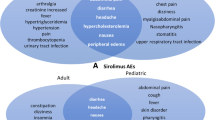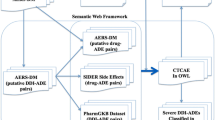Abstract
Introduction
A translational bioinformatics challenge exists in connecting population and individual clinical phenotypes in various formats to biological mechanisms. The Medical Dictionary for Regulatory Activities (MedDRA®) is the default dictionary for adverse event (AE) reporting in the US Food and Drug Administration Adverse Event Reporting System (FAERS). The ontology of adverse events (OAE) represents AEs as pathological processes occurring after drug exposures.
Objectives
The aim of this work was to establish a semantic framework to link biological mechanisms to phenotypes of AEs by combining OAE with MedDRA® in FAERS data analysis. We investigated the AEs associated with tyrosine kinase inhibitors (TKIs) and monoclonal antibodies (mAbs) targeting tyrosine kinases. The five selected TKIs/mAbs (i.e., dasatinib, imatinib, lapatinib, cetuximab, and trastuzumab) are known to induce impaired ventricular function (non-QT) cardiotoxicity.
Results
Statistical analysis of FAERS data identified 1053 distinct MedDRA® terms significantly associated with TKIs/mAbs, where 884 did not have corresponding OAE terms. We manually annotated these terms, added them to OAE by the standard OAE development strategy, and mapped them to MedDRA®. The data integration to provide insights into molecular mechanisms of drug-associated AEs was performed by including linkages in OAE for all related AE terms to MedDRA® and the existing ontologies, including the human phenotype ontology (HP), Uber anatomy ontology (UBERON), and gene ontology (GO). Sixteen AEs were shared by all five TKIs/mAbs, and each of 17 cardiotoxicity AEs was associated with at least one TKI/mAb. As an example, we analyzed “cardiac failure” using the relations established in OAE with other ontologies and demonstrated that one of the biological processes associated with cardiac failure maps to the genes associated with heart contraction.
Conclusion
By expanding the existing OAE ontological design, our TKI use case demonstrated that the combination of OAE and MedDRA® provides a semantic framework to link clinical phenotypes of adverse drug events to biological mechanisms.






Similar content being viewed by others
References
Zhichkin PE, Athey BD, Avigan MI, Abernethy DR. Needs for an expanded ontology-based classification of adverse drug reactions and related mechanisms. Clin Pharmacol Ther. 2012;91(6):963–5.
Brown EG, Wood L. Coding of data—MedDRA and other medical technologies. In: Rondel RK, Varley SA, Webb CF, editors, Clinical data management. Chichester: Wiley; 1999. doi:10.1002/0470846364.ch10.
Robinson PN, Köhler S, Bauer S, Seelow D, Horn D, Mundlos S. The human phenotype ontology: a tool for annotating and analyzing human hereditary disease. Am J Hum Genet. 2008;83(5):610–5.
Elkin PL, Brown SH, Husser CS, Bauer BA, Wahner-Roedler D, Rosenbloom ST, et al. Evaluation of the content coverage of SNOMED CT: ability of SNOMED clinical terms to represent clinical problem lists. Mayo Clin Proc. 2006;81(6):741–8.
World Health Organization. International statistical classification of diseases and related health problems. Geneva: World Health Organization; 2004.
Colevas A, Setser A. The NCI Common Terminology Criteria for Adverse Events (CTCAE) v 3.0 is the new standard for oncology clinical trials. J Clin Oncol. 2004;22(14S):6098.
National Cancer Institute. Common Terminology Criteria for Adverse Events (CTCAE): version 4.0. Available on line: http://evs.nci.nih.gov/ftp1/CTCAE/CTCAE_4.03_2010-06-14_QuickReference_8.5x11.pdf. 2012.
Ceusters W, Capolupo M, De Moor G, Devlies J, Smith B. An evolutionary approach to realism-based adverse event representations. Methods Inf Med. 2011;50(1):62.
He Y, Xiang Z, Sarntivijai S, Toldo L, Ceusters W. AEO: a realism-based biomedical ontology for the representation of adverse events. In: International Conference on Biomedical Ontology; 2011.
He Y, Sarntivijai S, Lin Y, Xiang Z, Guo A, Zhang S, et al. OAE: the ontology of adverse events. J Biomed Semant. 2014;5:29.
Smith B, Kumar A, Bittner T. Basic formal ontology for bioinformatics. J Inf Syst 2005:1–16. https://www.researchgate.net/profile/Barry_Smith4/publication/240744641_Basic_Formal_Ontology_for_Bioinformatics/links/0c96052e01c2e8c835000000.pdf. Accessed 15 Feb 2016.
Groza T, Köhler S, Moldenhauer D, Vasilevsky N, Baynam G, Zemojtel T, et al. The human phenotype ontology: semantic unification of common and rare disease. Am J Hum Genet. 2015;97(1):111–24.
Smith CL, Goldsmith CA, Eppig JT. The mammalian phenotype ontology as a tool for annotating, analyzing and comparing phenotypic information. Genome Biol. 2005;6(1):R7.
Schriml LM, Arze C, Nadendla S, Chang Y-WW, Mazaitis M, Felix V, et al. Disease Ontology: a backbone for disease semantic integration. Nucleic Acids Res. 2012;40(D1):D940–6.
Scheuermann RH, Ceusters W, Smith B. Toward an ontological treatment of disease and diagnosis. In: Proceedings of the 2009 AMIA Summit on Translational Bioinformatics, 2009. p. 116–20.
Malone J, Holloway E, Adamusiak T, Kapushesky M, Zheng J, Kolesnikov N, et al. Modeling sample variables with an experimental factor ontology. Bioinformatics. 2010;26(8):1112–8.
Sarntivijai S, Xiang Z, Shedden KA, Markel H, Omenn GS, Athey BD, et al. Ontology-based combinatorial comparative analysis of adverse events associated with killed and live influenza vaccines. PLoS One. 2012;7(11):e49941.
Tao C, He Y, Yang H, Poland GA, Chute CG. Ontology-based time information representation of vaccine adverse events in VAERS for temporal analysis. J Biomed Semant. 2012;3(1):13.
Lin Y, He Y. The ontology of genetic susceptibility factors (OGSF) and its application in modeling genetic susceptibility to vaccine adverse events. J Biomed Semant. 2014;5:19.
Marcos E, Zhao B, He Y. The ontology of vaccine adverse events (OVAE) and its usage in representing and analyzing adverse events associated with US-licensed human vaccines. J Biomed Semant. 2013;4(1):40.
Force T, Krause DS, Van Etten RA. Molecular mechanisms of cardiotoxicity of tyrosine kinase inhibition. Nat Rev Cancer. 2007;7(5):332–44.
Force T, Kerkelä R. Cardiotoxicity of the new cancer therapeutics—mechanisms of, and approaches to, the problem. Drug Discov Today. 2008;13(17):778–84.
Force T, Kolaja KL. Cardiotoxicity of kinase inhibitors: the prediction and translation of preclinical models to clinical outcomes. Nat Rev Drug Discov. 2011;10(2):111–26.
US National Library of Medicine. MedlinePlus [Internet] 2005 [cited 2014]. Available from: https://www.nlm.nih.gov/medlineplus/.
Smith B, Ashburner M, Rosse C, Bard J, Bug W, Ceusters W, et al. The OBO foundry: coordinated evolution of ontologies to support biomedical data integration. Nat Biotechnol. 2007;25(11):1251–5.
Xiang Z, Zheng J, Lin Y, He Y. Ontorat: automatic generation of new ontology terms, annotations, and axioms based on ontology design patterns. J Biomed Semant. 2015;6:4.
Xiang Z, Courtot M, Brinkman RR, Ruttenberg A, He Y. OntoFox: web-based support for ontology reuse. BMC Res Notes. 2010;3(1):175.
McGuinness DL, Van Harmelen F. OWL web ontology language overview. W3C recommendation. 2004;10(2004-03):10.
Xiang Z, Mungall C, Ruttenberg A, He Y, editors. Ontobee: a linked data server and browser for ontology terms. In: International Conference on Biomedical Ontology; 2011.
Arp R, Smith B. Function, role, and disposition in basic formal ontology. Nat Precedings. 2008;1941(1):1–4.
Harris MA, Clark J, Ireland A, Gene Ontology Consortium, et al. The gene ontology (GO) database and informatics resource. Nucleic Acids Res. 2004;32(Suppl 1):D258–61.
Brinkman RR, Courtot M, Derom D, Fostel JM, He Y, Lord P, et al. Modeling biomedical experimental processes with OBI. J Biomed Semant. 2010;1(Suppl 1):S7.
Gkoutos GV, Mungall C, Dolken S, Ashburner M, Lewis S, Hancock J, et al., editors. Entity/quality-based logical definitions for the human skeletal phenome using PATO. Engineering in Medicine and Biology Society, 2009 EMBC 2009 Annual International Conference of the Institute of Electrical and Electronics Engineers: Institute of Electrical and Electronics Engineers; 2009.
Ceusters W. An Information artifact ontology perspective on data collections and associated representational artifacts. Stud Health Technol Inf. 2012;180:68–72.
Mungall CJ, Torniai C, Gkoutos GV, Lewis SE, Haendel MA. UBERON, an integrative multi-species anatomy ontology. Genome Biol. 2012;13(1):R5.
He Y, Rappuoli R, De Groot AS, Chen RT. Emerging vaccine informatics. J Biomed Biotechnol. 2010;2010:218590.
He Y, Xiang Z. Databases and in silico tools for vaccine design. In Silico Models Drug Discov: Springer; 2013. p. 115–27.
Chibucos MC, Mungall CJ, Balakrishnan R, Christie KR, Huntley RP, White O, et al. Standardized description of scientific evidence using the evidence ontology (ECO). Database (Oxford). 2014. doi:10.1093/database/bau075. http://m.database.oxfordjournals.org/content/2014/bau075.long. Accessed 15 Feb 2016.
Acknowledgments
The authors thank Zuoshuang Xiang for his programming assistance in building OAE.
Author information
Authors and Affiliations
Corresponding author
Ethics declarations
Funding
This work was supported by the Oak Ridge Institute for Science and Education (ORISE) (Sirarat Sarntivijai), the Undergraduate Research Opportunity Program at the University of Michigan (Shelley Zhang, Desikan Jagannathan, Yongqun He), the Food and Drug Administration (FDA) Commissioner’s Fellowship Program (Shadia Zaman), National Institute of Environmental Health Sciences (NIEHS) Grant Number P30ES017885-01A1 (Gilbert Omenn), National Institutes of Health (NIH) Grant Numbers U54 DA021529 and UL1 TR000433-09 (Brian Athey), and National Institute of Allergy and Infectious Disease (NIAID) Grant Number R01 AI081062 (Yongqun He).
Conflict of interest
Sirarat Sarntivijai, Shelley Zhang, Desikan Jagannathan, Shadia Zaman, Keith Burkhart, Gilbert Omenn, Yongqun He, Brian Athey, and Darrell Abernethy have no conflicts of interest that are directly relevant to the content of this study.
Electronic supplementary material
Below is the link to the electronic supplementary material.
Rights and permissions
About this article
Cite this article
Sarntivijai, S., Zhang, S., Jagannathan, D.G. et al. Linking MedDRA®-Coded Clinical Phenotypes to Biological Mechanisms by the Ontology of Adverse Events: A Pilot Study on Tyrosine Kinase Inhibitors. Drug Saf 39, 697–707 (2016). https://doi.org/10.1007/s40264-016-0414-0
Published:
Issue Date:
DOI: https://doi.org/10.1007/s40264-016-0414-0




